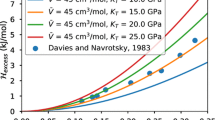Abstract
A statistical mechanical analysis of the limiting laws for coupled solid solutions shows that the random model, in which the configurational entropy is calculated as if atoms mix randomly on each crystallographic site, is correct as a first approximation. In coupled solid solutions, since atoms of different valence substitute on the same sites, significant short-range order which reduces the entropy can be expected. A first-order correction is rigorously obtained for the entropy in dilute binary short-range ordered coupled solid solutions:
where Q is the number of positions an associated cation pair can assume per formula unit, H A is the association energy per formula unit, and N a2 and N b4 are the site occupancy fractions for atoms 2 and 4 that are dilute on sites a and b. S XS is the configurational entropy minus the random model entropy. Aluminous pyroxenes on the joints diopside-jadeite and diopside-CaTs are examined as examples.
A generalization for dilute multiple component solutions, including possible long-range ordering variations is given by:
where i labels each crystallographically distinct pair, j and k label atomic species, l and m label crystallographic sites, and the N's are site occupancy fractions for the solute atoms.
A total association model is examined as well as the partial association and random models. Real solution behavior must lie between the total association model and the random model. Molecular models in which the ideal activity is proportional to a mole fraction, which in itself is not always unambiguously defined, do not lie in this range and furthermore have no physical justification.
Similar content being viewed by others
References
Bowen NL (1913) The melting phenomena of the plagioclase feldspars. Am J Sci 4th series 35:577–599
Bragg WH, Bragg WL (1915) X-rays and crystal structure. G. Bell and Sons, London
Bragg WL, Williams EJ (1935a) The effect of thermal agitation on atomic arrangement in alloys. Proc R Soc London, Ser A 145:699–729
Bragg WL, Williams EJ (1935b) The effect of thermal agitation on atomic arrangement in alloys II. Proc R Soc London, Ser A 151:540–566
Cohen RE (1984) Statistical mechanics of aluminous pyroxenes: Effects of short-range order on thermodynamic properties (abstract). GSA Abstracts with Programs 16:474
Cohen RE (1985a) Thermodynamics of Aluminous Pyroxenes: Effects of Short-Range Order. Ph.D. Thesis, Harvard University
Cohen RE (1985b) Thermodynamic properties of aluminous pyroxenes: Results of least squares refinements. GSA Abstracts with Programs 17(7)
Cohen RE (1986a) Least squares refinements of the thermodynamic properties of aluminous pyroxenes. Geochim Cosmochim Acta, in press
Cohen RE (1986b) Configurational thermodynamics of aluminous pyroxenes: A generalized pair approximation. Phys Chem Minerals 13:183–197
Cohen RE, Burnham CW (1985) Energy calculations and short-range order in aluminous pyroxenes. Am Mineral 70:559–567
Cohen RE, Post JE, Kirkpatrick RJ, Smith KA (1984) Energy calculations, NMR MASS, and short-range order in aluminous pyroxenes. EOS (Trans Am Geophys Union) 65:287
Darken LS, Gurry RW (1953) Physical Chemistry of Metals. McGraw-Hill, New York
Ganguly J (1973) Activity-composition relation of jadeite in omphacite pyroxene: Theoretical deductions. Earth Planet Sci Lett 19:145–153
Ganguly J, Ghose S (1979) Aluminous orthopyroxene: Orderdisorder, thermodynamic properties and petrologic implications. Contrib Mineral Petrol 69:375–385
Gasparik T, Newton RC (1984) The reversed alumina contents of orthopyroxene in equilibrium with spinel and forsterite in the system MgO-Al2O3-Si2. Contrib Mineral Petrol 85:186–196
Herzberg CT (1978) Pyroxene geothermometry and geobarometry: Experimental and thermodynamic evaluation of some subsolidus phase relations involving pyroxenes in the system MgO-Al2O3-SiO2. Geochim Cosmochim Acta 42:945–957
Kerrick DM, Darken LS (1975) Statistical thermodynamic models for ideal oxide and silicate solid solutions, with application to plagioclase. Geochim Cosmochim Acta 39:1431–1442
Kurepin VA (1978) A thermodynamic model of heterovalent solid solution under conditions of local electroneutrality. Geochem Int 15:12–24
Kurepin VA (1983) A thermodynamic model for a heterovalent solid solution with equilibrium deviation from local electrical neutrality. Geochem Int 20:147–157
Lane DL, Ganguly J (1980) Al2O3 solubility in orthopyroxene in the system MgO-Al2O3-SiO2: A reevaluation, and mantle geotherm. J Geophys Res B85:6963–6972
Müller RF (1964) Theory of the equilibria between complex silicate melts and crystalline solutions. Am J Sci 262:643–652
Newton RC, Wood BJ, Kleppa OJ (1981) Thermochemistry of silicate solid solutions. Bull Mineral 104:162–171
Perkins D III, Holland TJB, Newton RC (1981) The Al2O3 contents of enstatite in equilibrium with garnet in the system MgO-Al2O3-SiO2 at 15–40 kbar and 900–1,600° C. Contrib Mineral Petrol 78:99–109
Saxena SK (1981) The MgO-Al2O3-SiO2 system: Free energy of pyrope and Al2O3-enstatite. Geochim Cosmochim Acta 45:821–825
Thompson JB, Jr (1969) Chemical reactions in crystals. Am Mineral 54:311–375
Ulbrich HH, Waldbaum DR (1976) Structural and other contributions to the third-law entropies of silicates. Geochim Cosmochim Acta 40:1–24
Waldbaum DR (1973) The configurational entropy of Ca2MgSi2O7-Ca2Al2SiO7 melilites and related minerals. Contrib Mineral Petrol 39:33–54
Wood BJ (1979) Activity-composition relationships in Ca(Mg, Fe)Si2O6-CaAl2SiO6 clinopyroxene solid solutions. Am J Sci 279:851–875
Wood BJ, Banno S (1973) Garnet-orthopyroxene and orthopyroxene-clinopyroxene relationships in simple and complex systems. Contrib Mineral Petrol 42:109–124
Wood BJ, Holloway JR (1984) A thermodynamic model for subsolidus equilibria in the system CaO-MgO-Al2O3-SiO2. Geochim Cosmochim Acta 48:159–176
Wood BJ, Nicholls J (1978) The thermodynamic properties of reciprocal solid solutions. Contrib Mineral Petrol 66:389–400
Author information
Authors and Affiliations
Rights and permissions
About this article
Cite this article
Cohen, R.E. Statistical mechanics of coupled solid solutions in the dilute limit. Phys Chem Minerals 13, 174–182 (1986). https://doi.org/10.1007/BF00308160
Received:
Issue Date:
DOI: https://doi.org/10.1007/BF00308160




